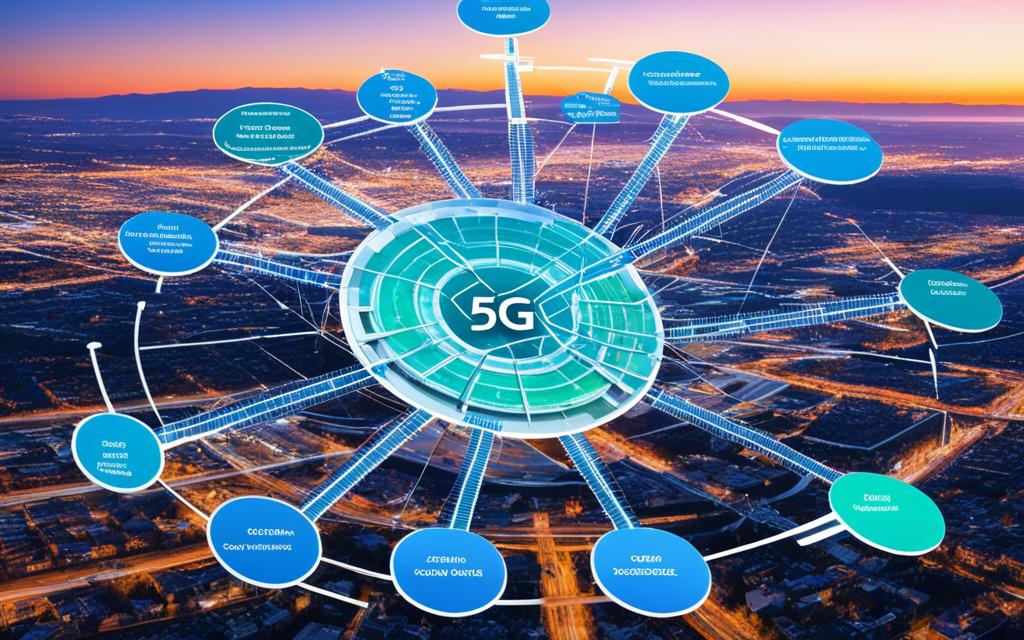Satellite network slicing offers exciting possibilities for the provision of customized services in the realm of communication. By dividing the network into multiple partitions, each dedicated to a specific service, satellite operators can cater to the unique requirements of various vertical markets and deliver tailor-made connectivity solutions. This integration of satellite networks with terrestrial networks through network slicing presents new opportunities for enhanced communication experiences and seamless connectivity across industries.
To implement network slicing in satellite networks, the evolution of satellite technologies and the application of software-defined network (SDN) and network function virtualization (NFV) paradigms are required. These advancements will enable the provision of specialized satellite services, ensuring that industries have access to the custom communication solutions they need.
What is 5G Network Slicing?
5G network slicing is a revolutionary approach to network configuration that allows for the customization of a network into separate “slices.” Each network slice is tailored to specific use cases, catering to the unique requirements of different applications and services. This transformative technology empowers network operators to allocate resources efficiently, providing tailored communication services to various vertical markets.
The concept of network slicing is particularly beneficial in 5G networks, where diverse applications with different demands coexist. Whether it’s high-speed data transfer, low-latency connections, or ultra-reliable communication, network slicing enables customized network configurations to meet specific needs.
By utilizing 5G network slicing, communications service providers (CSPs) can offer a wide range of services, applications, and use cases. This tailored approach allows CSPs to address and fulfill the unique requirements of different vertical markets, whether it’s autonomous vehicles, smart factories, healthcare, or any industry with specific communication needs.
Let’s take a closer look at how 5G network slicing enables customized network configuration and opens up opportunities for various vertical markets.
| Benefits of 5G Network Slicing | Use Cases |
|---|---|
| 1. Customized resource allocation for specific services | 1. Autonomous vehicles with low-latency requirements |
| 2. Enhanced network performance for targeted applications | 2. Smart factories with high-speed data transfer needs |
| 3. Improved network efficiency and resource utilization | 3. Healthcare applications with stringent reliability demands |
Challenges of 5G Network Slicing in Satellite Networks
The implementation of 5G network slicing in satellite networks poses several challenges. The complexities associated with managing network slices in satellite environments present significant hurdles that need to be addressed for successful deployment. The existing network management procedures, which are built on outdated operations and maintenance practices, must be adapted to support the dynamic nature of network slicing.
One of the challenges lies in the maturity of the ecosystem surrounding 5G network slicing in satellite networks. The market for multi-slice supported terminals is still in its early stages, and standardization efforts are ongoing. These limitations hinder the seamless integration and widespread adoption of network slicing technology.
Furthermore, the modification of telco business models and the design of delivery modes pose open questions that require exploration. As network slicing introduces new opportunities and service offerings, telcos need to re-evaluate their business strategies to fully capitalize on the potential revenue streams.
Overcoming these challenges is imperative in realizing the full potential of satellite network slicing. By addressing the complexities, maturing the ecosystem, and refining business models, satellite networks can harness the benefits of 5G network slicing to improve service delivery and meet the diverse needs of various industries.
Opportunities of 5G Network Slicing in Satellite Networks
5G network slicing presents significant opportunities for Communication Service Providers (CSPs) in satellite networks. With network slicing, CSPs gain greater control and flexibility over their network environment, allowing them to cater to the specific needs of their customers and tap into new revenue streams.
The dynamic nature of network slicing empowers CSPs to create customized network slices based on various criteria such as application types, security, mobility, traffic types, and quality of service (QoS). This level of service customization enables CSPs to offer tailored communication services and personalized experiences, catering to the specific requirements of different industry verticals.
By leveraging 5G network slicing in satellite networks, CSPs can introduce services that require different functionalities, services at the edge, quick time-to-market services, and services that demand enhanced isolation. This capability opens doors to new business models, enabling CSPs to increase their return on investment while addressing the diverse needs of their customers.
With network slicing, CSPs can explore revenue generation opportunities through:
- Service differentiation: Offering specialized services with unique functionalities and performance guarantees.
- Vertical market targeting: Providing customized solutions for specific industry verticals, such as agriculture, transportation, or healthcare.
- Partnership collaborations: Collaborating with ecosystem partners to develop and deliver innovative slice-enabled services.
- Monetization of infrastructure: Optimizing network resources and generating additional revenue by leasing slices to third-party service providers.

Conclusion
Satellite network slicing in 5G networks presents exciting opportunities for the provision of customized communication services across diverse industry sectors. By dividing the network into multiple slices, each tailored to specific requirements, network operators can effectively address the varied needs of their customers while seamlessly integrating satellite and terrestrial networks. Despite the challenges posed by managing complexities and adapting business models, the advantages of satellite network slicing, including revenue generation, enhanced efficiency, and improved connectivity, position it as a promising technology for the future.
Through continued research, innovation, and collaboration, the full potential of satellite network slicing can be realized, enabling a broad spectrum of tailored services to address global communication needs. The ability to create network slices based on different criteria, such as application types, security, mobility, traffic types, and quality of service (QoS), empowers communication service providers (CSPs) to offer personalized experiences and tap into new revenue streams. This dynamic nature of network slicing enhances CSPs’ control and flexibility over their network environment, ensuring that they can cater to the specific requirements of different industry verticals.
As satellite network slicing evolves, it will play a crucial role in meeting the demand for specialized satellite services and further enhancing connectivity in various industry sectors. By embracing this technology, CSPs can unlock new business models, increase their return on investment, and deliver services that require different functionalities, such as services at the edge, services with quick time-to-market, and services that require better isolation. With its potential to revolutionize the communication landscape, satellite network slicing marks a significant step towards a future where customized services are a norm, opening up a world of possibilities for businesses and individuals alike.
FAQ
What is satellite network slicing?
Satellite network slicing is a paradigm that allows for the creation of multiple partitions in a network, with each partition dedicated to a particular service. This enables vertical markets and multiple services with different requirements to run on a single infrastructure.
What is 5G network slicing?
5G network slicing involves the configuration of a network in which one domain is divided into separate “slices” that can be customized for specific use cases. Each network slice can cater to the unique requirements of different applications and services, such as high speeds, low latency, or ultra-reliability.
What are the challenges of implementing 5G network slicing in satellite networks?
The increased complexity of managing network slices in satellite networks poses a significant hurdle. The current network management procedures, which are based on decades-old operations and maintenance (O&M) practices, need to be adapted to support the dynamic nature of network slicing. Ecosystem limitations, such as an immature market for multi-slice supported terminals and a lack of standardization, also need to be addressed.
What opportunities does 5G network slicing present for CSPs in satellite networks?
Network slicing enables CSPs to have more control and flexibility over their network environment. They can create network slices based on different criteria, such as application types, security, mobility, traffic types, and quality of service (QoS). This dynamic nature of network slicing opens the door to new revenue streams and personalized experiences for customers.
How does satellite network slicing benefit the provision of customized communication services?
By dividing the network into multiple slices, each tailored to specific requirements, network operators can meet the diverse needs of their customers and enable seamless integration between satellite and terrestrial networks. The benefits of satellite network slicing, including revenue generation, improved efficiency, and enhanced connectivity, make it a promising technology for the future.



















